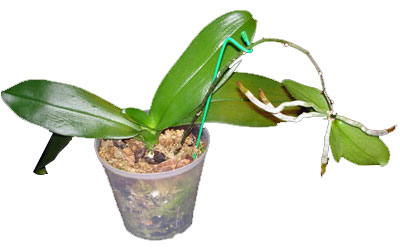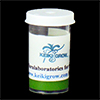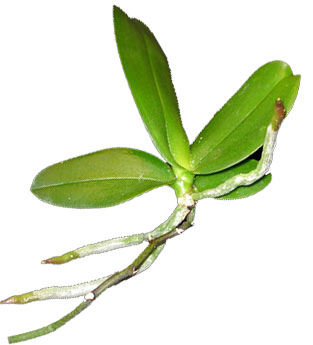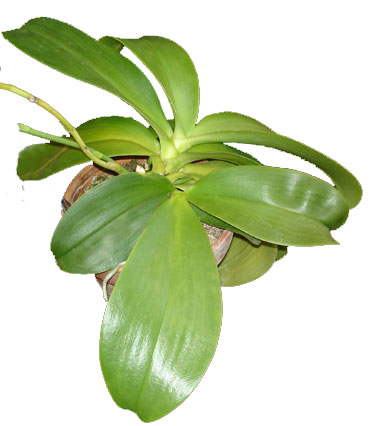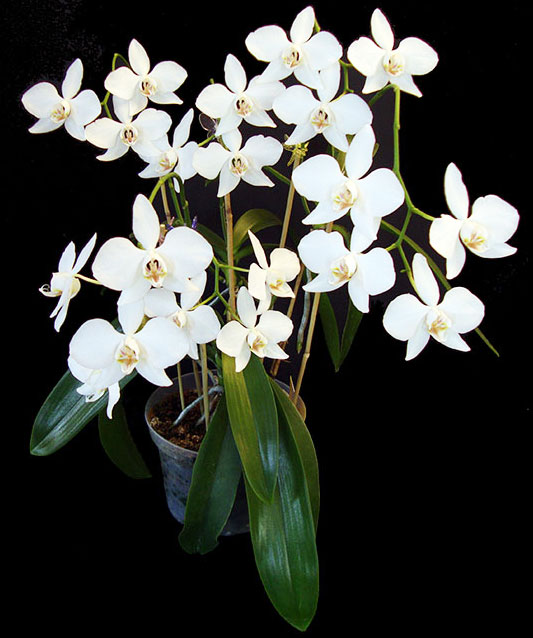
Orchid Keikis
Some orchids can bear little plantlets off flower stems or pseudobulbs. These little baby plants are often called Keikis (Hawaiian for "baby").
Keikis are seen most frequently on Phalaenopsis, Epidendrum, and Dendrobium. Shown here is a healthy Phalaenopsis orchid that has a baby plant (keiki) that has grown out of the bloom stem. This little baby plant is genetically identical to its mother and will bear flowers that look like the mother's.
If you would like to have a Keiki of your own to grow, these authentic KeikiGrow Plus products below will help you to do so.
Authentic
KeikiGrow Plus can be applied to a node on the bloom stem to stimulate the growth of a keiki.
|
|
Accept no substitutes! This is the original formulation developed by the famous Dr. James Brasch decades ago as described in the American Orchid Society publications.
We are happy to offer this miraculous cloning product that is both fun and effective for "making" new orchids. Keikis are baby orchids and this formula makes it easy to create a new keiki either from the base or from a node on a bloom spike ( more typical ). The new baby will be genetically identical to the parent or source plant, and it is about the simplest way we know of to get a new baby just like the original.
Cloning for fun, or because the parent plant is failing are both great reasons to use this effective formula. We send instructions for use with each plastic jar and the amount you get goes a long way. Just a very small dab is required to get the process going and formation usually begins in a matter of weeks!
Once a Keiki has roots of 1-3 inches, it is time to repot both the mother and the baby. We recommend planting both together in the same pot in fresh mix. When keiki's are very small they seem to do best in the same pot with the mother for the first year because the mother plant helps regulate moisture conditions in the pot. We snip off the Keiki about an inch or two down the spike (or stalk) and gently set the little plant next to the mother and encourage the roots to go downward and establish themselves in the pot. It's ok to bury a bit of the cut off flower spike with the keiki, usually we bend it straight down in an attempt to anchor the little one.
A different kind of keiki, called a basal keiki, can develop at the base of a Phalaenopsis orchid. Under the bottom leaves, along the main stem, are dormant nodes which can develop into a new growth. This type of keiki is left on the plant. This type of keiki is seen more often in older Phalaenopsis orchids as part of the natural growth pattern over the years or in younger orchids as a result of stress. We have even seen cases where a Phalaenopsis completely dies back from crown rot only to sprout an entirely new shoot from the base. These growths tend to grow very quickly, fueled by the large root system of the mother plant. KeikiGrow Plus can be used on the dormant nodes at the base of an orchid to stimulate new growth.
Can KeikiGrow Plus cure crown rot? Well the answer is yes and no! Once the crown is damaged to the extent that the upper leaf has rotted, a Phalaenopsis or any other monopodial plant will not continue to grow. It may not die immediately, but the ability to produce new leaves and the accompanying flower spike is virtually impossible. That is the bad news. The good news is that when the crown is damaged the adventitious buds at the base of the plant begin to enlarge and in their native habitat may even grow into a new plant. By the careful use of KeikiGrow Plus this process can be enhanced and in over 90% of the applications a new plant will develop.
When crown rot has damaged the plant, apply a thin layer of KeikiGrow Plus to the base of the plant where the bottom leaves fell off as the plant was growing. At the base of every leaf is an adventitious bud-ready to replace the crown. Do not water the plant, but keep it warm (70 degrees F) and in high humidity (80-90%). Use a plastic bag if necessary. A new growth and perhaps three or four growths will establish on the old roots and then grow their own roots so that they can be removed and potted up safely. The new "clone" should bloom within one or two years. This procedure is useful for Angraecums, Doritis or any similar plants and of course the relevant hybrids are especially easy to rescue.
We may also choose to leave the baby on the parent and both will bloom in due time which can be very pretty. Shown here is our species Phal amabilis which has two keiki's on each of two old bloom spikes. These keikis formed on the mother plant after it bloomed the previous year. We chose to leave them on the mother plant and they bloomed along with the mother the next year. Each keiki has one bloom spike and the mother plant has two new bloom spikes.
This orchid, from our private collection, has since been repotted with the two keikis together in a pot and the mother plant in another pot.

